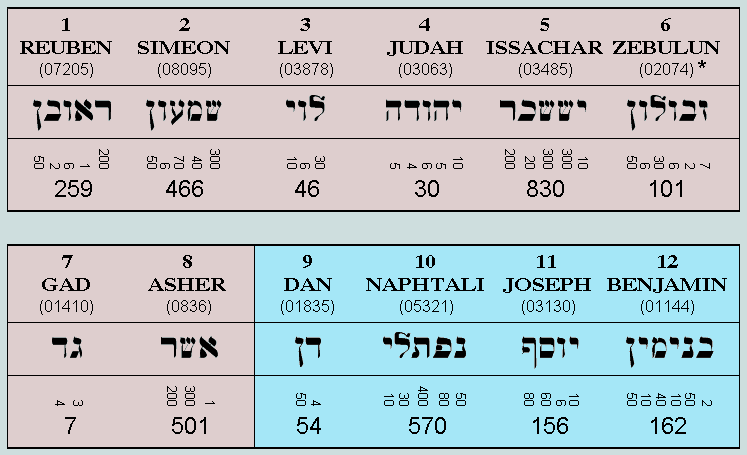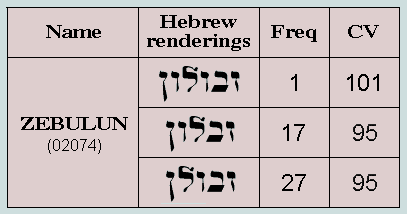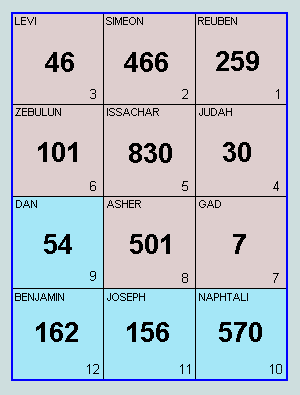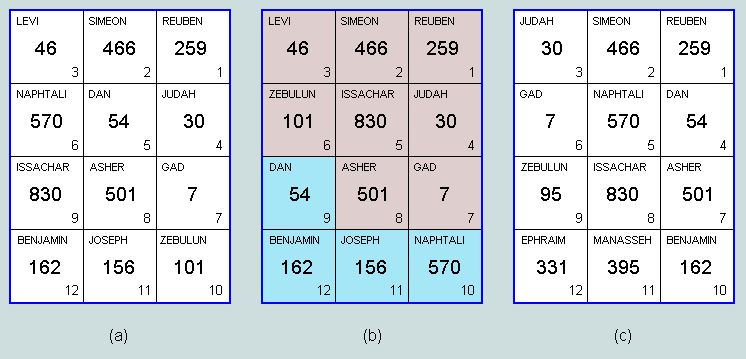
Appendix 1 - The Twelve Sons of Israel
Jacob, whose name was changed to Israel, fathered 12 sons by four women: his wives, Leah and Rachel; and his concubines - maidservants of Leah and Rachel - and surrogate mothers, Zilpah and Bilhah (Genesis 29:31-35; 30:1-24; 35:16-18). The following table lists the names of the sons, in order of birth, with their respective mothers.
- 1. REUBEN - Leah
- 2. SIMEON - Leah
3. LEVI - Leah
4. JUDAH - Leah
5. DAN - Rachel/Bilhah
6. NAPHTALI - Rachel/Bilhah
7. GAD - Leah/Zilpah
8. ASHER - Leah/Zilpah
9. ISSACHAR - Leah
10. ZEBULUN - Leah
11. JOSEPH - Rachel
12. BENJAMIN - Rachel
A careful study of this list reveals a secondary birth order, this time along matriarchal lines. Such an interpretation receives support from the Scriptural record, where the struggle between the sisters - Leah and Rachel - for the affections of their husband is recounted at Genesis 29 and 30. Consequently, we may reconfigure the birth order after the houses of the two wives, Leah and Rachel. In so doing, precedence is given to the house of Leah: her own six sons first, then her two surrogate sons by Zilpah. Subsequently we have the house of Rachel: her two surrogate sons by Bilhah - given precedence as they were the first to be born into Rachel's house - followed finally by Rachel's own two sons, Joseph and Benjamin. An amended table listing the sons of Israel, after the matriarchal birth order, is as follows:
- 1. REUBEN - Leah
2. SIMEON - Leah
3. LEVI - Leah
4. JUDAH - Leah- 5. ISSACHAR - Leah
6. ZEBULUN - Leah- 7. GAD - Leah/Zilpah
8. ASHER - Leah/Zilpah- 9. DAN - Rachel/Bilhah
10. NAPHTALI - Rachel/Bilhah- 11. JOSEPH - Rachel
12. BENJAMIN - Rachel
Many centuries
after the advent of Israel it became the practice to use Hebrew
letters as numerals. All written words and names have since
become fairly interpretable as numbers. Details of the Hebrew
alphabetic numbering scheme are given in Appendix 2. The names engraved on the jewels of the
breastplate, in their matriarchal birth order, and with their
full numerical interpretations, are listed in the table below
along with their Strong's reference number bracketed. [Note: to
verify these Hebrew spellings you may access www.blueletterbible.org using the relevant reference number.]

* In contrast to the other 11, the Hebrew rendering of the name Zebulun occurs in different ways - as detailed below:

Observe that the column headed 'Freq(uency)' records the number of times each variation occurs in the Old Testament text; and that headed 'CV', the numerical values to be associated with these. For the purposes of the current exercise, it is clear that latter may be read either as 101 or 95. The first is preferred here because, (a) even though the associated variation occurs only once, it alone represents the complete spelling of the name and, (b) it is this value that raises the total of the 'Sons of Israel' to a significant multiple of 37, and the one which establishes many of the internal MS breastplate characteristics.
The birth order, above, resembles very nearly that found at Genesis 46, the only difference being in Rachel's house where Joseph and Benjamin precede Dan and Naphtali. Observe the colour scheme: Leah's house rendered pink, and Rachel's blue.
From these data, the breastplate grid - termed the Mother Set (MS) - may now be prepared for analysis as a 4 x 3 matrix of CV names:

At this juncture a few points need to be addressed concerning the breastplate. In a previous page, 'An Oracle Restored', the breastplate grid was overlaid with the names of the 12 tribes of Israel - not quite the same thing as the 12 sons of Israel (see 'An Oracle Restored'). Surprisingly, neither the MS nor the grid as per 'An Oracle Restored' can lay claim to being the original breastplate order. In spite of this fact, however, they both fulfill the Scriptural condition concerning the breastplate, that it be representative of birth order! Below is the true breastplate grid (a), with the MS (b) and 'Oracle' (c) grids alongside.

Note also at (a) and (b) that Zebulun has a CV of 101, the full spelling of the name. In Scripture Zebulun appears with three different spellings, two of which produce a CV of 95, as at (c). On the true breastplate, the full spelling would undoubtedly have applied.
2004-11-20